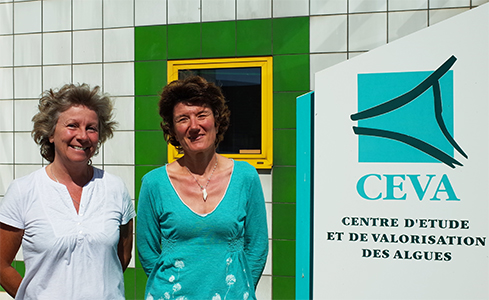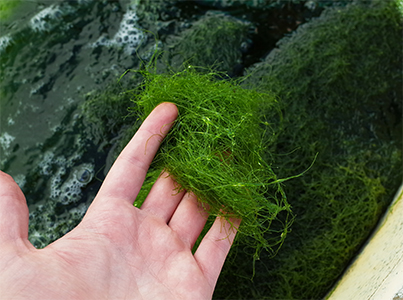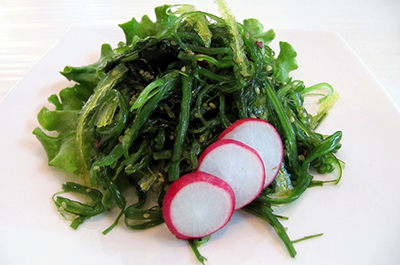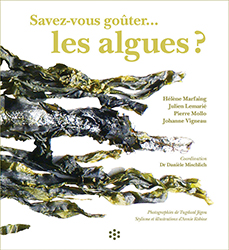Muriel Cathaud meets Hélène Marfaing, agricultural engineer, agri-food project manager at CEVA (Centre d’Etude et de Valorisation des Algues) and co-author of the book “Savez-vous goûter… les algues?

Can you tell us a little about CEVA and its main missions?
The CEVA, based in Pleubian (Côtes d’Armor, Brittany, France), is a private research organization recognized as a European expert center for marine plants. Founded in 1982 to respond to the needs of local authorities faced with the problem of algal blooms (green tides), CEVA quickly turned its attention to the development of new products and processes to meet the demands of companies wishing to use the properties of algae. CEVA has extensive experience in the development of algal and plant ingredients, the cultivation of macro- and microalgae and their use in various fields: food, cosmetics, materials, chemistry, etc.
What is your background and how did you get to CEVA?
I trained in the agri-food sector, particularly in the dairy industry. I was fascinated by milk as a raw material. This ingredient can be used to make a wide range of products including butter, cheese, yoghurt and cream desserts. Transformation technologies using ferments and the associated biochemistry are really interesting.
I’ve always been interested in cooking (I’m very greedy by nature), food and health, but also the sea, sailing and marine energy, following a class at sea which really triggered my interest.
As a result, I’ve been able to combine these 2 passions at CEVA since 2001, when I arrived in the region. I’m in charge of agri-food and nutrition development. In other words, I help companies learn about seaweed and its nutritional benefits, develop products and seaweed processing techniques, and assess regulatory constraints. I also work on more collaborative projects, where several people brainstorm on possible research and development related to algae. All this is underpinned by one of CEVA’s missions, which is to develop the economic sector linked to algae.

Would you say that seaweed, which is becoming increasingly well-known in the West for its qualities and virtues, will be used more and more in the future?
Yes, clearly, there’s a real craze for these plants from the sea or microalgae. It’s an underlying trend that goes hand in hand with the growing awareness of the French about the composition of their food: origin, quality and health.
To be completely scientific, there are no official data on French seaweed consumption. Only consumer studies provide an insight into interest, consumption levels and the seaweed products most appreciated by the French. Two recent studies have been carried out in France, renewing old data compiled over 10 years ago (Brault & al, 2002).
The results of these 2 recent consumer studies demonstrate, first and foremost, a growing awareness of seaweed among consumers: 86% of those questioned knew that seaweed could be eaten (Litzer, 2013). These results reflect an evolution in the perception of seaweed. In 2002, we pointed out that “seaweed has one major problem: it is not considered a food product” (Brault & al, 2002).
As a result, seaweed consumption is on the rise. Whereas in 2000, only 30% of the French population had consumed seaweed this figure had doubled by 2013: 58% of the French population has already consumed seaweed (Ritter & al, 2013). This development is mainly linked to the spread of Asian restaurants: 58% of those surveyed had in fact visited an Asian restaurant, and the seaweed products consumed in order of importance were sushi (93%), soups (62%) and salads (36%). Seaweed is clearly perceived as natural and healthy. Informed consumers recognize its high mineral, fiber and vitamin content.
What are the main “macro” and “micro” seaweeds consumed in France today? How and by whom?
Globally, we produce and consume more macroalgae (100 times more) than microalgae. It’s important to distinguish between Asian and Western algae consumption. In Asia (Japan, Korea), consumption is estimated at between 4 and 14 g of dry macroalgae per day. The most widely consumed seaweeds are Nori, wakame and kombu. Most seaweed is consumed as a condiment, in soups, salads, garnishes mixed with other vegetables or as a vinegar-based condiment.
Dried red Nori seaweed, transformed into fine black leaves, is used to wrap sushi, maki or onigiri, but can also be eaten as seasoned leaves (sesame, chili, soy sauce) as an aperitif, or as flakes to sprinkle on vegetable dishes and salads. Its marine aromas (reminiscent of grilled sardine skin), as well as smoky tea and dried mushrooms, are released in the mouth, where its crunchy texture becomes melt-in-the-mouth. Japanese nori is generally prepared either plain or with soy sauce. Korean nori is prepared with oil, salt, sesame seeds or chili pepper. It is often more open-faced, light and crispy.
Wakame, a brown seaweed, is mainly sold dried, to be rehydrated in salads or soups, such as Miso soup. It has recently appeared in Western sushi bars in the form of a wakame salad seasoned with sesame. In South Korea, when a woman gives birth, she is offered wakame soup 2 or 3 times a day for 3 weeks. Rich in iodine, magnesium and other minerals, wakame is ideal for the mother’s recovery, as well as that of the child she will be breast-feeding. On each child’s birthday, wakame soup is made to commemorate the birth (Moon & Kim, 1999).

Kombu, a brown kelp, is the basic ingredient of dashi (Japanese broth), but can also be used in papillotes around fish or as a condiment in vinegar. It was in konbu broth that Japanese scientist Ikunae Ikeda described the umami flavor, which in Japanese means “delicious” or “savory”. The molecule responsible for this flavor is sodium glutamate, naturally present in the seaweed.
In the West and Europe, consumption is much lower. As a joke, we could say that a French person consumes in one year the amount of seaweed that a Japanese person eats in 1 day! But this is changing, as we saw in the paragraph above.
There are 6 main types of edible seaweed available in France: Haricot de mer, Dulse, Laitue de mer, Nori, wakame and kombu royal.
The most widely consumed microalgae are organic spirulina and chlorella, mainly in the form of dietary supplements to date.
Can we expect to see new seaweed products on the market in the near future?
Yes, some producers and manufacturers are keen to use different types of algae from those currently on offer. But it’s a fairly long process, and not necessarily visible to consumers in the short term.
You are co-author of the book “Savez-vous goûter …les algues?”
…with plankton scientist Pierre Mollo, star chefs Julien Lemarié and Johanne Vigneau, coordinated by Danièle Mischlich, public health physician (www.presses.ehesp.fr). What is the story behind this beautiful book?
The adventure began over a year ago, when Danièle Mischlich contacted me about participating in this collective work. She had taken the precaution of sending me a copy of the previous book in the collection, “Savez-vous goûter les légumes secs” (“Do you know how to taste pulses?”), and I’d been blown away by its blend of history, science and cooking. So I agreed to collaborate on this collective work, a beautiful book whose ambition is to combine the views of men, women, scientists, chefs and restaurateurs from different backgrounds, and to talk about both macroalgae and microalgae, presenting them succinctly while highlighting their nutritional benefits, and teeming with recipe ideas and practical advice.
Which seaweeds do you personally consume? Do you have a “favorite” recipe?
Personally, I eat spirulina for breakfast. And I regularly eat brown seaweed salads with sesame (wakame, sea beans, kombu royal or Atlantic wakame, depending on what I have on hand). It’s very simple to make: after a quick blanch, I add salt to the seaweed to soften it and store it in the fridge (or you can buy it in organic stores in “fresh salted” trays). After desalting, I cut them into fine julienne strips and make a vinaigrette with sesame oil, cider vinegar, fresh ginger, a dash of brown sugar, salt and toasted sesame seeds. Combine seaweed and sauce and marinate for a few hours. It’s delicious, fresh and full of vitality.
I also love using dried sea lettuce powder in desserts; I find that it has a bitterness akin to Matcha green tea, and works wonderfully in desserts with white chocolate, raspberries or almond powder (as in financiers that turn all green!).
Sea beans are an easy-to-use seaweed that’s perfect for the whole family: cooked with or without pasta, they make delicious tagliatelle for Bolognese, Carbonara or Japanese-style dishes. Crystallized in sugar and coated in chocolate, it makes a seaside savory that delights every gourmet.
Do you have any advice for our readers in terms of diet and well-being?
I don’t really have any advice to give. However, it’s important to realize that what we eat helps to build us up, so a healthy, balanced diet helps us to be at our healthiest. But above all, you have to enjoy eating and cooking, be curious about everything and listen to yourself to find out what’s good for you.
What’s your favorite quote?
Oh, I don’t really have a master to think of! Let’s just say “Carpe diem”.
To order the book “Do you know how to taste…seaweed?”


